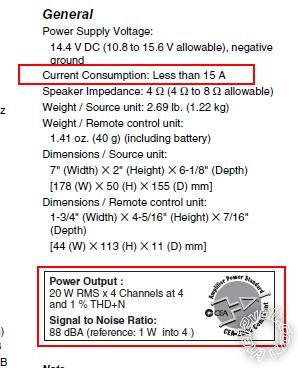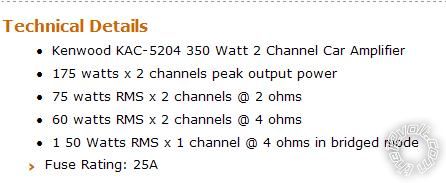Below is my current set up,
93 Excel (walled)
Clarion HU
4-Niche6.5"comps/tweets
4-Niche 15" subs sealed
1-JLAudio JX1000/1D
75amp Alt (no headlight dim, no votage drop,,,ever)
So my question is, since the amp on my deck is 20X4 rms, if I disconnect that and put on an additional extrenal amp for the highs that is say 75x2rms (@2ohms), will it make ANY difference on the draw to the alternator?
the deck is a Clarion CZ209 and the amp is Kenwood specs below, and will it sound better?


-------------
2004 Hyundai Sonata
Kenwood KDC-X599 HU
2-Sundown X-18D4
2-SQ Q4500.1
2-SQ Q90.4
1-Massive DBX4
8-Niche 5.25 mids
8-Niche Tweeters
4-Skar 8" mid-bass
OhioGen 220a alt
OhioGen 350a alt
156.0
Wull... Yeah. But no, too... It'll be a trade.
Your deck is 20X4 (shyah...) for 80 watts.
80 watts divided by 12 is about 6.75A. YOu SHOULD BE ABLE to subtract that currrent demand from the total of the sheet, listed above, and arrive at roughly 8.25A for the deck power demands without driving a load.
Now... The amplifier you are deciding to install, at 150W, will pull about 15A alone, driven WFO.
So... We started with 15A for the deck, driving speakers.
Now, we remove the deck amplifier from the picture, leaving us 9.25A.
The amp you want to add ia a 15A drain on it's own.
15A + 9.25A = 24.25A
You are going to have the potential to pull more current with deck and discrete amplifer, than deck alone.
Will it sound better? Possibly. Only you can decide that, but I'd bet dollars to donuts that it would sound at least marginally better. It will be louder, and the ear's natural response is to think the "louder" sounds "better". Be careful of that little "stigma". It just happens!

-------------
It all reminds me of something that Molière once said to Guy de Maupassant at a café in Vienna: "That's nice. You should write it down."
I have a volt/ohm/amp meter, how do I measure the amps coming from the alternator?
at battery when car is on?
-------------
2004 Hyundai Sonata
Kenwood KDC-X599 HU
2-Sundown X-18D4
2-SQ Q4500.1
2-SQ Q90.4
1-Massive DBX4
8-Niche 5.25 mids
8-Niche Tweeters
4-Skar 8" mid-bass
OhioGen 220a alt
OhioGen 350a alt
156.0
What kind of ammeter is it? Clamp on? If so, it's probably only for AC, and you won't be able to measure current. They DO make clamp on DC ammeters, but they're expensive.
DC ammeters you usually have to break the circuit, and insert the leads into the break. Those types of meters are usually also for lower currents... I've never seen one rated for higher than 20A.
-------------
It all reminds me of something that Molière once said to Guy de Maupassant at a café in Vienna: "That's nice. You should write it down."


